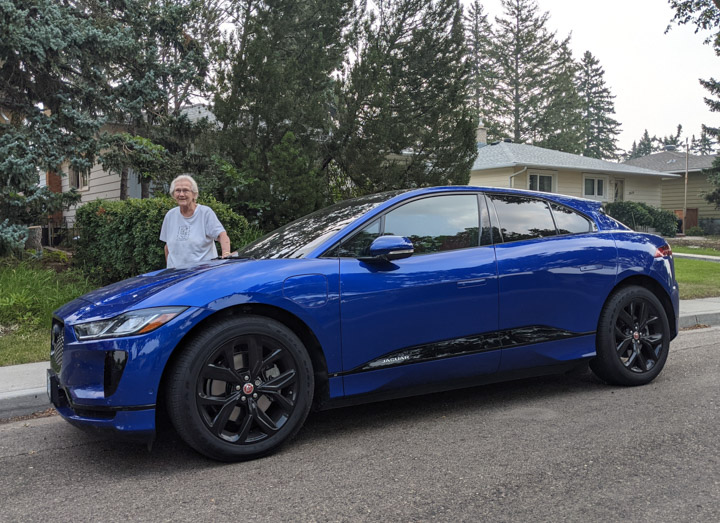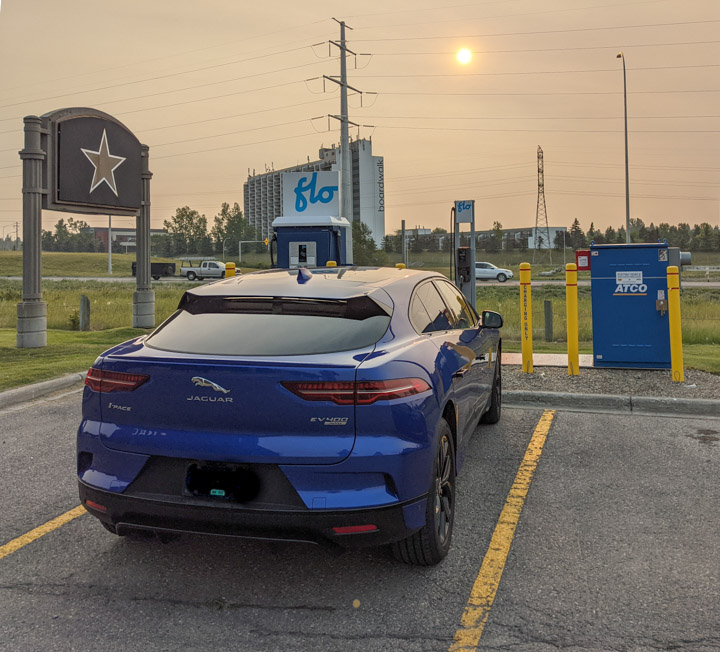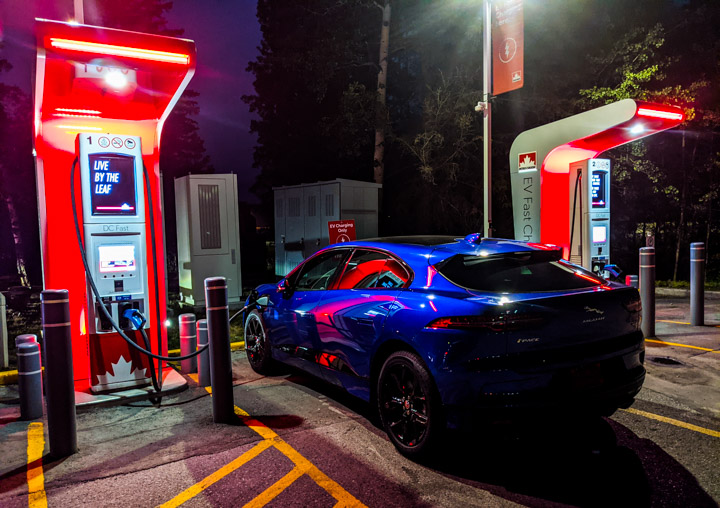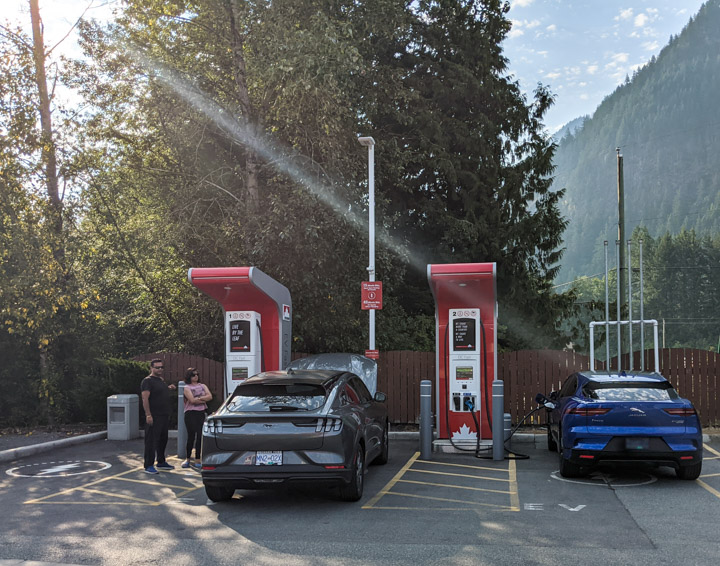
At 6:30 PM on Wednesday August 4th my 15-year-old daughter and I pulled up the Jaguar I-Pace electric car in front of my 91-year-old Mom’s place in Regina, Saskatchewan. I was tired and achey because I’d just finished driving 1,725km (1,072 miles) across two days to see her for the first time since Covid started. I was happy to see Mom, happy about the first road-trip in a long time, and happy to have tested the hypothesis that, in 2021, a fully-electric vehicle can handle long-haul travel.
My Mom, welcoming us to Saskatchewan. Normally she doesn’t look like the queen.
This essay gathers together the data from the trip and tries to draw conclusions. There’s also a real-time Twitter thread with typos and bad pictures.
To my non-metric readers: Sorry, it’s in km. I’ll convert a few of the key numbers.
The experience · It was pretty wonderful, actually. The Jaguar is a comfortable modern car with great seats, good audio, and all the automation you’d expect. It has awesome, overwhelming acceleration power for when you’re in a tricky passing situation. My daughter was excellent company. Cruising along a good road — and a lot of the Trans-Canada highway is — becomes a pretty pleasing experience.
The worst part, by a wide margin, was the wildfire smoke, between us and some of the world’s most fantastic scenery. But that’s a symptom of the onrushing climate crisis, and one of the best things we can do to mitigate the devastation is to stop burning fossil fuels to travel.
Smoky sun while charging in West Hills Mall, Calgary
Of course, this road trip was different from any previous experience, because charging. In a fossil car, you don’t have to think, you just wait for the tank to get a half or three quarters down, then pull over at the next station. Recharging requires planning; fortunately the tools are pretty good; more on that below.
The chargers · One reason I decided this experiment was worth trying was Petro-Canada’s message about their Electric Highway program, and I quote: “We have a charger every 250 km or less from Halifax, N.S. to Victoria, B.C.” There’s one not far from where I live in Vancouver, i tried it, and it worked first time with just a credit-card tap, no fuss no muss.
Trouble is, that quote is kind of a lie. There are gaps, and that’s when all the chargers are working, which fairly regularly they’re not. But my experience is that Petro-Can, while good, is never your only charging option.
Some background is required here. “High-power” Fast DC chargers come at multiple power levels: I saw 50, 100, 200, and 350kW. The difference makes a difference. Our Jag can only really charge at 100kW, but my personal perception is that the higher-power chargers fill up that last 20% much faster. And it feels complicated; for example, in my experience with a Co-op Connect charger, rated at “only” 100kW, it felt faster.
When you use these things, they feel like first-generation tech, pushing the edges of what’s possible (or at least maintainable). In particular, when you plug a 350kW charger into a car with a really low battery, once it’s finished syncing and starts pumping electrons, the sound torques up like a 747 taking off. And the installations include multiple big tall metal boxes (see the picture below). Also, the huge big thick connecting wire gets super hot to the touch.
Charging can be glamorous!
Anyhow, my impression of the Petro-Can network remains mostly positive. The machines work well. It’s annoying that some are 100kW, some 200, and some 350, for no obvious reason. It’s annoying that sometimes they’re stuck into a weird grubby back corner of the lot in a way that makes it hard to get your car in the right position to reach the charging port with the wire. But, good on ’em.
Electrify Canada is another organization that’s promising a national network of fast chargers. They’re a partner of Electrify America, constructed by Volkswagen as part of their settlement over cheating on emissions testing. Anyhow, maybe they’ll be great some day. Once I was far enough into the trip to have Petro-Can fully worked out, I tried to find an Electrify charger in working condition but failed.
If you’re OK with using 50kW chargers there are loads and loads of options. Many smaller-town Visitor Centres and and Chambers of Commerce put one in, as has my own electrical utility, BC Hydro. Once you’ve worked with a higher-power charger though, they’re just not a satisfying experience.
The numbers · Each line in the table below represents one driving leg and includes the charging experience at the beginning of that leg (thus absent on each day’s initial leg). I think the column headings are mostly pretty obvious, except perhaps for:
kWh/h is the amount of juice divided by the driving pause. Often the charger would report less time, which I put down to initialization delay, so I think I’m using the right value. The variation here is a little random, because how fast it goes depends strongly on how empty your battery is.
km/ch stands for “km per charge-hour”, estimating the amount of road range you get per hour of charging. Which I think is a really important number.
Network; “PC” is Petro-Canada, “Flo” isn’t an acronym, and “Co-op” is Co-op Connect.
There are two data sources: The drive-time data is from Jaguar’s trip logging via their Incontrol app; thus the awkwardness caused by non-charge roadside stops. The charge-time data is the output from the various charging sessions along the way. I’m certain that neither is perfect, but the results seem intuitively in the right neighborhood, based on my experience.
| Charging, | then driving | ||||||||||||||
|---|---|---|---|---|---|---|---|---|---|---|---|---|---|---|---|
| Start time | End time | Charge time | kWh | $ | $/kWh | kWh/h | km/ch | Network | Start | End | Drive time | km | Speed | Regen | kWh/100km |
| 6:26 | 8:00 | PC | Vancouver | Hope | 1:34 | 149.5 | 96 | 1.6 | 23.6 | ||||||
| 8:46 | 10:32 | 0:46 | 28.3 | 10.37 | 0.37 | 36.91 | 148.94 | PC | Hope | Kamloops | 1:46 | 193.8 | 112 | 3.5 | 26.7 |
| 11:26 | 12:46 | 0:54 | 55.8 | 13.97 | 0.25 | 62.00 | 250.17 | PC | Kamloops | Salmon Arm | 1:20 | 113.8 | 87 | 3.3 | 20.4 |
| 13:32 | 16:25 | 0:46 | 27.1 | 9.53 | 0.35 | 35.35 | 142.63 | PC | Salmon Arm | Golden | 2:53 | 248.8 | 88 | 6.9 | 22.4 |
| 17:11 | 17:25 | 0:46 | 48.8 | 10.70 | 0.22 | 63.65 | 256.83 | PC | Golden | (roadside) | 0:14 | 18.1 | 69 | 1.0 | 33.0 |
| 17:25 | 19:06 | (roadside) | Canmore | 1:41 | 146.0 | 89 | 1.9 | 21.4 | |||||||
| 5:49 | 6:51 | 60.4 | 21.20 | 0.35 | PC | Canmore | Calgary | 1:02 | 101.2 | 96 | 1.6 | 23.9 | |||
| 7:44 | 9:51 | 0:53 | 22.3 | 13.85 | 0.62 | 25.25 | 101.86 | Flo | Calgary | (roadside) | 2:07 | 221.8 | 107 | 2.7 | 23.1 |
| 10:03 | 10:39 | (roadside) | Medicine Hat | 0:36 | 64.1 | 108 | 0.8 | 23.9 | |||||||
| 11:45 | 13:56 | 1:06 | 72.5 | 21.08 | 0.29 | 65.91 | 265.94 | PC | Medicine Hat | Swift Current | 2:11 | 230.0 | 107 | 1.4 | 25.5 |
| 14:50 | 16:24 | 0:54 | 54.0 | 14.28 | 0.26 | 60.00 | 242.10 | PC | Swift Current | Moose Jaw | 1:34 | 170.7 | 110 | 1.1 | 25.6 |
| 16:43 | 17:27 | 0:19 | 23.0 | 5.54 | 0.24 | 72.63 | 293.07 | Co-op | Moose Jaw | Regina | 0:44 | 67.1 | 92 | 0.8 | 27.9 |
| Total | 6:24 | 392.20 | $120.52 | 0.31 | 66.18 | 17:42 | 1724.9 | 26.6 | |||||||
| Average | 0:48 | 43.6 | $13.39 | 52.7 | 212.7 | 1:28 | 143.74 | 97.5 | 24.8 | ||||||
Let’s have a closer look at the numbers that seem interesting to me.
Charge time · 17:42 driving, 6:24 charging (including one evening charge after the day’s drive was finished). Not that great on the face of it. Now, it clearly could have been less; since my confidence that any given charger would Just Work started out weak, I was carefully allowing for failures and not running the battery very low. Later on in the trip as I gained confidence (specifically in the Petro-Canada network) I was willing to take on things like the Calgary-to-Medicine Hat leg, 2:43 and 285.9km, running the battery from 90% down to 11%.
Also my daughter is after all a teen-ager, and perhaps not quite as quick as I moving through cafes and restrooms and so on.
Also note that the legs are kind of short; this car can go 400km on a charge. But not when you’re on a big wide modern Prairie highway with almost no other traffic, blasting along at 110km/h (65mph) or more, continuously. I think you’d find this true of pretty well every electric vehicle.
But, here’s the thing: It didn’t feel excessive. I can only remember a total of maybe fifteen minutes when we were consciously just hanging waiting for charge. Most places, we got a coffee or lunch, hit the bathroom, took a walk around the block for our knees’ sake, and then it was time to unplug and go.
Having said that, this is a 2019 model-year car and the charging technology is improving. If we’d had a Porsche Taycan and nothing but 350kW chargers, the story would have been very different. Will the fast-charging technology make the leap into the mainstream-car price plane? Will 350kW chargers become ubiquitious? I’d like to know.
In this context, there’s another number there that I think is really interesting: The “km/c-h”, how far you can get on an hour’s charge. For this particular car on this selection of chargers, it was over 200km (124 miles) per charge-hour. I think that’s enough? Maybe in the lower regions of enough, but there.
And finally, I suspect every driving-safety professional would beam in approval of a power system that forces you to get out of the car and move around every couple of hundred km.
$$$ · It cost us $120.52 in electricity. Is that a lot or a little? I tentatively think they’re undercharging. While the electricity itself is pretty cheap, the charging infrastructure isn’t. If this is going to work, the charging networks are going to have to make money and I don’t see it at these prices.
Bear in mind that at home with the Level 2 charger in the carport, charging feels close to free. Travel maybe doesn’t need to be as cheap as the networks are currently making it.
Also, charging by the minute seems wrong. I guess having a time-based component makes sense to keep slow chargers from soaking up all the time, but especially at an extra-high-powered charger, a Porsche Taycan is going to get a whole lot more range out of each minute than a five-year-old Nissan Leaf, so why should they pay less for the same amount of range? Hmmmm.
PlugShare · If you’ve got a Tesla there’s less planning, the cars know where the Superchargers are. If you have anything else, you really need PlugShare. There are a few apps in this space, but PlugShare is best at showing you a map with all the chargers on it, and thus helping you route-plan. The reason it works is because it’s social; whenever you hit a charging station you can “Check In” and leave a note saying whether it’s working and how fast it goes. This dramatically reduces the risk of rolling up to a station and finding it broken. I absolutely don’t think this journey would have been possible without it.
Pro tip: When you’re planning a trip on PlugShare, put in all the chargers you might be able to use as you go along. Then when you’re driving, you can look at your remaining range and your upcoming options and most choices become pretty easy. It’s got a limited but decent Android Auto app that I used a lot. (I assume CarPlay too?)
Jaguar I-Pace and Mustang Mach-E charging up in Hope, BC.
Futures · A question: Are there enough chargers, or too many? At the moment, the answer is probably “too many”. One of the things I really worried about was limping into some charging station to find all the chargers occupied and having to wait for an hour before I could even start. The picture above shows the only time I saw other humans; a young couple with a four-day-old Mustang Mach-E, off for a joyride to Kamloops. Otherwise, the chargers we visited showed no signs of life. Somebody spent a lot of money to build an expensive resource that is today largely un-used.
Having said that, anyone with even a shred of optimism about our future has to believe there are going to be a whole lot more battery-electric cars coming. Here in BC at the west edge of Canada we have North America’s highest EV uptake, pushing 10% of new car sales.
When we were charging at the big Petro-Can station in Kamloops, walking from the the two well-positioned chargers to the coffee shop, we went by the gas-sales part, which was massive, at least a dozen pumps and cars lined up for every one.
At some point that picture will flip, and there’ll be occasional vendors that still sell gas, but mostly just slick, fast, chargers. I worry that the process will be kind of painful, but I’m sure it’ll happen. So I hope someone’s planning the transition.
Would you do it again? · Definitely.
And everyone should stop driving fossil vehicles starting now. Because the climate crisis is upon us. We can’t prevent it now, but we can save lives and reduce destruction if we slash carbon output. There’s no excuse not to.
如有侵权请联系:admin#unsafe.sh



